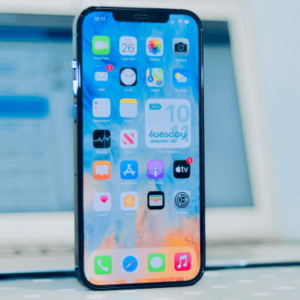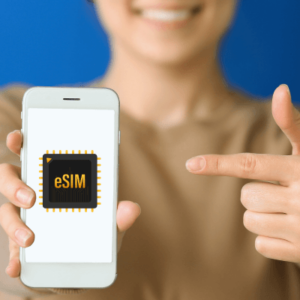With every passing year, these gadgets undergo significant transformations, becoming smarter, faster, and more intuitive. The integration of eSIM technology is a key advancement in smartphones, offering the potential for major design innovations in the industry. This article examines the evolution of smartphones and the impact of eSIM.
What is a Smartphone?
A smartphone is a versatile mobile device blending phone capabilities with PC-like features such as internet access, apps, and touchscreen technology. Evolving from bulky gadgets to sleek, powerful devices, smartphones now support a wide range of tasks from calls and messaging to complex activities like video editing and gaming.

What is an eSIM?
An eSIM, or embedded Subscriber Identity Module, is a digital SIM that allows users to activate a cellular plan from their carrier without having to use a physical nano-SIM. Embedded directly into the device during manufacturing, eSIMs are rewritable, meaning users can switch operators without changing the SIM card. This technology represents a significant leap from traditional SIM cards, offering travel flexibility, improved security, and a seamless user experience.

The Impact of eSIM on Smartphone Design
The introduction of eSIM technology is not just a step forward in terms of connectivity; it’s also poised to revolutionize smartphone design in several ways:
- Slimmer Devices: With the need for a SIM card tray eliminated, designers have more freedom to create slimmer, more streamlined devices. This extra space can be used to enhance other components, like batteries, or to make the phones lighter.
- Seamless Design: Without the physical requirements for a SIM slot, smartphones can achieve a more seamless design. This could lead to entirely new aesthetics for smartphones, focusing on minimalism and sleekness.
- Enhanced Durability: No SIM slot increases water/dust resistance and durability.
- Innovative Features: Allows for foldable designs and advanced tech integration.
- Greater Connectivity: Facilitates easy carrier switching and potentially better rates.
How to Connect eSIM to Smartphones
Connecting an eSIM to your smartphone involves a straightforward process that typically requires you to scan a QR code provided by your carrier or manually input activation details. First, ensure your device supports eSIM technology and that your carrier offers eSIM plans. Go to your phone’s settings, select the cellular or mobile data option, and choose “Add Cellular Plan.” Scan the QR code to configure your eSIM automatically, or manually input details like the SM-DP+ address and activation codes. Once activated, you can easily manage and switch between eSIM plans on your device, providing greater convenience and flexibility than traditional SIM cards.

Cost of Smartphones with eSIM Technology
Smartphones with eSIM technology are generally priced similarly to those with traditional SIM slots, with variations depending on brand, model, and features. The addition of eSIM does not notably raise a device’s cost; instead, factors like design, camera quality, processor speed, and display impact the price. Premium models with eSIM and advanced specifications cost more, while an expanding selection of mid-range and budget smartphones now offer eSIM support, broadening access to this technology without significantly affecting the price.
Current Smartphones with eSIM Technology
- Apple iPhone 13 Series: Offers eSIM and Dual SIM capabilities, ideal for travelers and business users.
- Google Pixel 6: Features impressive cameras and eSIM support, suited for those seeking flexibility and Android’s ecosystem.
- Samsung Galaxy S21 Ultra: Flagship with eSIM, advanced cameras, and AMOLED display, targeting tech enthusiasts.
- Huawei P40 Pro: Includes eSIM, enhancing its strong photography features and sleek design.
- Microsoft Surface Duo 2: A foldable device supporting eSIM, designed for productivity with dual screens.
Challenges and Opportunities of eSIM in Smartphones
While the transition to eSIM technology presents numerous advantages, it also poses challenges. These include regulatory hurdles, the need for widespread carrier support, and concerns about consumer choice and control over their data. However, these challenges also offer opportunities for innovation, pushing the industry towards more user-friendly, flexible, and secure standards for mobile communication.
Challenges:
- Compatibility: Not all smartphones support eSIM technology, limiting its use to newer, compatible models.
- Carrier Support: Limited carrier support for eSIM in some regions can be a hurdle for users wanting to switch or activate services.
- Technical Issues: Potential technical glitches with activation and switching between plans may occur, requiring troubleshooting.
- Consumer Awareness: Low awareness and understanding of eSIM benefits among consumers can slow adoption rates.
Opportunities:
- Seamless Connectivity: eSIM allows for easier international travel and switching between carriers without physical SIM swaps.
- Device Innovation: Encourages the development of smaller, more integrated devices without the need for SIM card slots, freeing up space for other technologies.
- Market Expansion: Opens new markets for cellular-enabled devices beyond phones, like smartwatches and wearables, and IoT devices.
- Sustainability: Reduces the need for plastic SIM cards, contributing to environmental sustainability efforts.
Testimonials
“Switching to eSIM was a game-changer for me. The process was incredibly easy, and I love how it freed up space for other features on my phone. It’s the future of connectivity.” – Alex M., Tech Enthusiast
“I’ve always been skeptical about new technology, but eSIM won me over. Switching carriers without changing SIM cards is a convenience I never knew I needed. Plus, my phone feels more durable without the SIM slot. Huge win for someone as clumsy as me!” – Jenna S., Freelance Photographer
“Traveling with eSIM technology has transformed my international experiences. Gone are the days of juggling multiple SIM cards or worrying about roaming charges. Now, I can easily choose the best plan for my needs, wherever I am in the world.” – Raj P., World Traveler
“From a design perspective, eSIM opens up so many possibilities. We’re no longer constrained by the need to accommodate a physical SIM, which means more room for innovation. I’m excited to see where this takes smartphone design in the next few years.” – Lena K., Industrial Designer
Conclusion
The integration of eSIM technology marks a pivotal change, reshaping smartphone design, user experience, and mobile connectivity. Looking ahead, eSIM promises to bring substantial innovation, making smartphones more intelligent and adaptable to our evolving needs.
Ready to explore the future of mobile technology and start your seamless connectivity journey? Click here to discover the best eSIM options worldwide and unlock the full potential of your smartphone today. Take the chance to be at the forefront of this revolutionary shift in telecommunications!
By adopting a forward-thinking approach and leveraging eSIM technology, users can enjoy unparalleled convenience, flexibility, and freedom in connecting, communicating, and interacting with the world around them.



